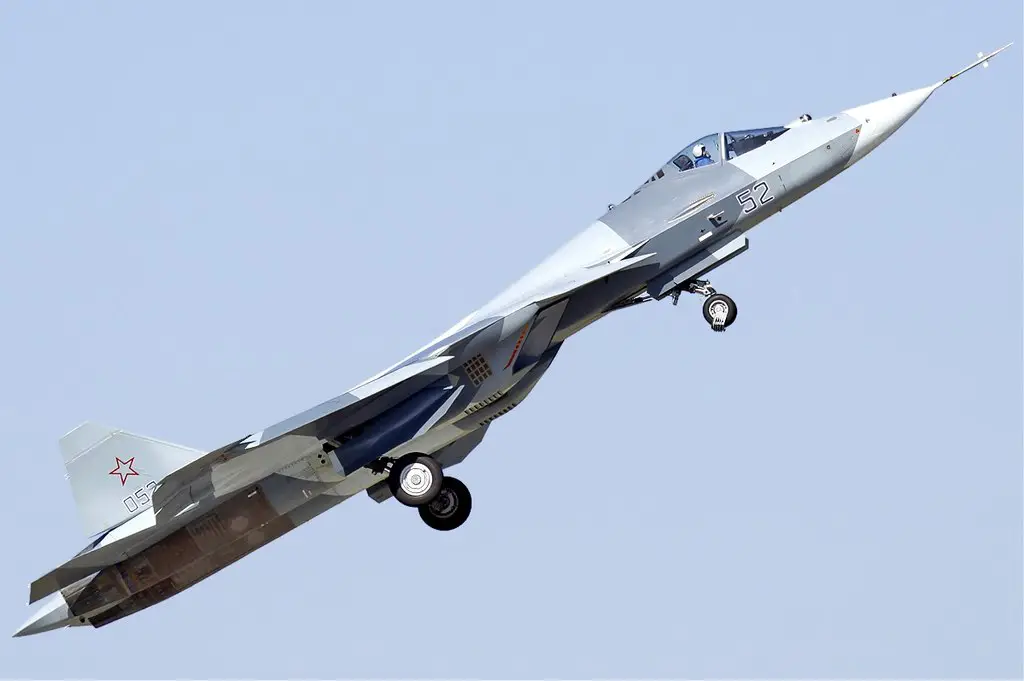Special polymeric covers will hide the main units of the fifth-generation Su-57 fighter jets at airfields from adversary optical-electronic systems and radars. They will also protect the body and sophisticated equipment in bad weather. Experts believe the knowhow will help Russian aircraft units rapidly redeploy the forces to any region of the world, the Izvestia daily writes.
Follow Air Recognition on Google News at this link
 Su-57 climbing after takeoff, 2011. (Picture source: Wikipedia/Dmitry Zherdin)
Su-57 climbing after takeoff, 2011. (Picture source: Wikipedia/Dmitry Zherdin)
The supplies of Su-57 covers will begin in 2021, Defense Ministry sources said. Each jet will have a dozen covers for the wheels, low, central, and back fuselage, wing consoles, cockpit, nozzle, stabilizers, air intakes and other parts. The contract stipulates supplies up to 2028. Eight sets will be made in 2021-2022 and the production will accelerate after that.
The covers have a double mission. Firstly, they better and longer protect the coating and electronics. Modern fighter jets carry antennas, sensors, optical and electronic systems on the wing and fuselage. Radar designer Yuri Bely earlier said Su-57 was the first jet to use the so-called smart coating technology which distributes active phased antenna arrays along the body of the jet. In contrast to previous radars with antennas in the front of the aircraft, the smart coating provides a round view to hundreds of kilometers rather than the front hemisphere. The media has numerously reported problems with stealth coating of US F-22. It demands costly repairs in case of damage.
Secondly, the covers will hide the aircraft from foreign intelligence services which display major interest in it. The special material will hide Su-57 from electronic reconnaissance. It will be impossible to identify it on satellite and air photos.
"The adversary will not know where the aircraft are based, how many of them are deployed and where from and to they were redeployed," former Commander of the 4th air force and defense army Lieutenant-General Valery Gorbenko said. "Today it is only possible to hide them underground. It is also necessary to protect modern hardware against bad weather. Today they sometimes fully cover aircraft, but it does not protect them against rain or snow. In southern regions, sand storms erase the paint like emery," he said.
As a rule, fighter jets are kept in hangars or under tents. The covers for Su-57 help keep them in green field, Merited test pilot Colonel Igor Malikov said. The aircraft can also be rapidly redeployed to standby airfields without tents.
"The Russian aviation may be needed in various parts of the world. If we cannot provide an aircraft with a roof over the head, we have to supply it with reliable covers. They cost less than an aircraft. The fighter jets have to be concealed from reconnaissance. Their outside electronics have to be protected against bad weather," he said.
Producers are currently fulfilling contracts for 76 Su-57. The development batch of the aircraft is to complete acceptance trials in 2020. The jets have twice operated in Syria and delivered strikes at terrorists with new smart missiles and bombs designed for them. Military experts said all missions had been successfully fulfilled.
The planned Su-57 production pace is to be reached in 2024. The Megapolis R&D has to produce the upgraded second-phase option of the jet by the time. It will have new-generation engines, better avionics and an expanded range of precision weapons, the Izvestia said.
© Copyright 2020 TASS. All rights reserved. This material may not be published, broadcast, rewritten or redistributed.
















